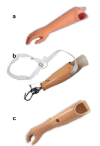Peromelia - congenital transverse deficiency of the upper limb: a literature review and current prosthetic treatment
- PMID: 30607202
- PMCID: PMC6293328
- DOI: 10.1302/1863-2548.12.180107
Peromelia - congenital transverse deficiency of the upper limb: a literature review and current prosthetic treatment
Abstract
Peromelia or congenital transverse deficiency describes a truncation of the upper limb below various limb levels. Recommendations regarding treatment vary and are mainly based on expert opinions. This paper summarizes the current literature regarding the aetiology, pathogenesis and specifically treatment algorithms for children with peromelia. We performed a non-systematic review of the current literature from MEDLINE/PubMed to obtain comprehensive up-to-date information about peromelia, focusing on current recommendations for the treatment of peromelia (e.g. prosthetic fitting, external stump lengthening). The current literature lacks clear evidence as to whether prosthetic treatment is superior to prosthetic non-usage. However, based on the available studies, children with transradial or transhumeral peromelia should preferably be fitted with passive/cosmetic prostheses at the age between six and 24 months, followed by active/myoelectric devices at the age of 2.5 to four years. It remains controversial whether early myoelectric prosthetic fitting can reduce prosthesis rejection times; however, cognitive readiness and the ability to absolve a guided training programme are seen as important prerequisites for myoelectric fitting. Children with very short stumps may benefit from stump lengthening using external fixators and prosthetic modification. The treatment of children with peromelia generally requires a guided, multidisciplinary team approach. A training programme is essential to optimize individuals' performance in the execution of activities of daily living and decrease rejection risks whenever a myoelectric device is prescribed. Myoelectric fitting should preferably be commenced at no later than four years of age. However, long-term reports on the benefits of prosthetic treatment are still pending.
Keywords: congenital hand difference; congenital hand malformation; peromelia; transverse deficiency; upper limb.
Figures




References
-
- Jain S, Lakhtakia PK. Profile of congenital transverse deficiencies among cases of congenital orthopaedic anomalies. J Orthop Surg (Hong Kong) 2002;10:45–52. - PubMed
-
- Tadchjian Mo. Congenital deformities. Pediatric orthopedics. Vol 1 2nd ed. Philadelphia: W.B. Saunders, 1990:104–112.
-
- Kozin SH. Upper-extremity congenital anomalies. J Bone Joint Surg [Am] 2003;85-A:1564–1576. - PubMed
-
- Gonzalez CH, Marques-Dias MJ, Kim CA, et al. . Congenital abnormalities in Brazilian children associated with misoprostol misuse in first trimester of pregnancy. Lancet 1998;351:1624–1627. - PubMed
-
- Fantel AG, Barber CV, Mackler B. Ischemia/reperfusion: a new hypothesis for the developmental toxicity of cocaine. Teratology 1992;46:285–292. - PubMed
LinkOut - more resources
Full Text Sources

